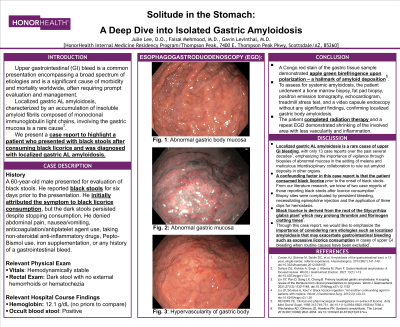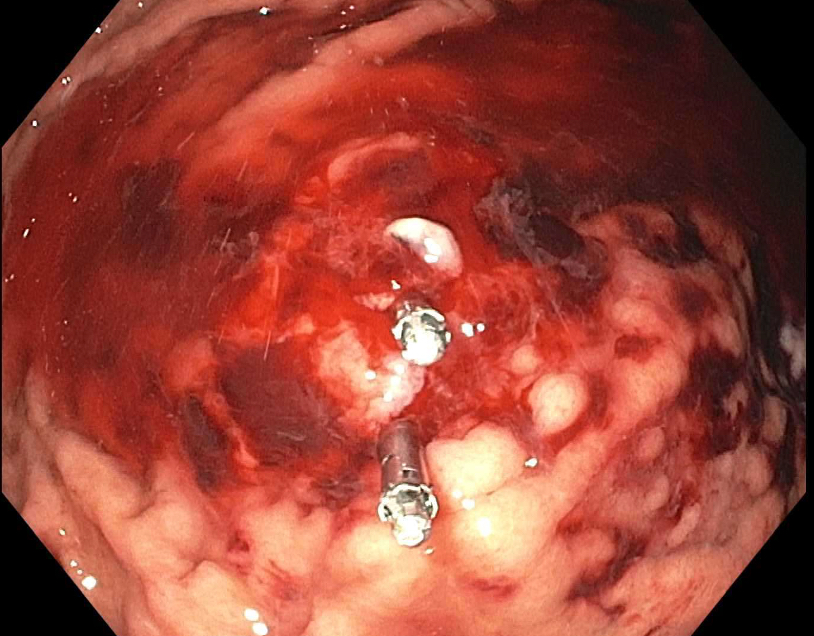Tuesday Poster Session
Category: Stomach
P5083 - Solitude in the Stomach: A Deep Dive Into Isolated Gastric Amyloidosis
Tuesday, October 29, 2024
10:30 AM - 4:00 PM ET
Location: Exhibit Hall E

Has Audio
- JL
Julie Lee, DO
HonorHealth
Scottsdale, AZ
Presenting Author(s)
Julie Lee, DO, Faisal Mehmood, MD, Gavin Levinthal, MD
HonorHealth, Scottsdale, AZ
Introduction: Upper gastrointestinal (GI) bleed is a common presentation encompassing a broad spectrum of etiologies and is a significant cause of morbidity and mortality worldwide. Localized gastric AL amyloidosis, characterized by an accumulation of insoluble amyloid fibrils composed of monoclonal immunoglobulin light chains, involving the gastric mucosa is a rare cause. We present a case report to highlight a patient who presented with black stools after consuming black licorice and was diagnosed with localized gastric AL amyloidosis.
Case Description/Methods: A 60-year-old male presented for evaluation of black stools. He reported black stools for six days. He initially attributed the symptom to black licorice consumption, but the dark stools persisted. Initial hemoglobin was 12.1 g/dL. Occult blood stool was positive. Esophagogastroduodenoscopy (EGD) revealed hypervascularity and abnormal thickening of the gastric mucosa, particularly notable in the gastric body along the greater curvature, prompting targeted biopsies. Biopsy sites were complicated by persistent bleeding, necessitating epinephrine injection and the application of three clips for hemostasis. The unique aspect of the case report materialized with the pathological analysis of the gastric mucosa, revealing chronic gastritis and amyloid deposition. A Congo red stain demonstrated apple green birefringence upon polarization – a hallmark of amyloid deposition. Furthermore, subtyping revealed the classification as AL amyloidosis. A bone marrow biopsy, fat pad biopsy, positron emission tomography, echocardiogram, treadmill stress test, and a video capsule endoscopy were completed without findings of systemic amyloidosis.
Discussion: Localized gastric AL amyloidosis is a rare cause of upper GI bleeding, with only 13 case reports over the past several decades. A confounding factor in this case report is that the patient consumed black licorice prior to the onset of black stools. Literature research revealed two case reports of those reporting black stools after licorice consumption. Black licorice is known to be derived from the root of the Glycyrrhiza glabra plant which may prolong thrombin and fibrinogen clotting times. Through this case report, we would like to emphasize the importance of considering rare etiologies such as localized amyloidosis and other factors that may exacerbate gastrointestinal bleeding such as excessive licorice consumption in cases of upper GI bleeding when routine causes have been excluded.

Disclosures:
Julie Lee, DO, Faisal Mehmood, MD, Gavin Levinthal, MD. P5083 - Solitude in the Stomach: A Deep Dive Into Isolated Gastric Amyloidosis, ACG 2024 Annual Scientific Meeting Abstracts. Philadelphia, PA: American College of Gastroenterology.
HonorHealth, Scottsdale, AZ
Introduction: Upper gastrointestinal (GI) bleed is a common presentation encompassing a broad spectrum of etiologies and is a significant cause of morbidity and mortality worldwide. Localized gastric AL amyloidosis, characterized by an accumulation of insoluble amyloid fibrils composed of monoclonal immunoglobulin light chains, involving the gastric mucosa is a rare cause. We present a case report to highlight a patient who presented with black stools after consuming black licorice and was diagnosed with localized gastric AL amyloidosis.
Case Description/Methods: A 60-year-old male presented for evaluation of black stools. He reported black stools for six days. He initially attributed the symptom to black licorice consumption, but the dark stools persisted. Initial hemoglobin was 12.1 g/dL. Occult blood stool was positive. Esophagogastroduodenoscopy (EGD) revealed hypervascularity and abnormal thickening of the gastric mucosa, particularly notable in the gastric body along the greater curvature, prompting targeted biopsies. Biopsy sites were complicated by persistent bleeding, necessitating epinephrine injection and the application of three clips for hemostasis. The unique aspect of the case report materialized with the pathological analysis of the gastric mucosa, revealing chronic gastritis and amyloid deposition. A Congo red stain demonstrated apple green birefringence upon polarization – a hallmark of amyloid deposition. Furthermore, subtyping revealed the classification as AL amyloidosis. A bone marrow biopsy, fat pad biopsy, positron emission tomography, echocardiogram, treadmill stress test, and a video capsule endoscopy were completed without findings of systemic amyloidosis.
Discussion: Localized gastric AL amyloidosis is a rare cause of upper GI bleeding, with only 13 case reports over the past several decades. A confounding factor in this case report is that the patient consumed black licorice prior to the onset of black stools. Literature research revealed two case reports of those reporting black stools after licorice consumption. Black licorice is known to be derived from the root of the Glycyrrhiza glabra plant which may prolong thrombin and fibrinogen clotting times. Through this case report, we would like to emphasize the importance of considering rare etiologies such as localized amyloidosis and other factors that may exacerbate gastrointestinal bleeding such as excessive licorice consumption in cases of upper GI bleeding when routine causes have been excluded.

Figure: Hypervascularity and abnormal thickening of the gastric mucosa, biopsy sites complicated by persistent bleeding.
Disclosures:
Julie Lee indicated no relevant financial relationships.
Faisal Mehmood indicated no relevant financial relationships.
Gavin Levinthal indicated no relevant financial relationships.
Julie Lee, DO, Faisal Mehmood, MD, Gavin Levinthal, MD. P5083 - Solitude in the Stomach: A Deep Dive Into Isolated Gastric Amyloidosis, ACG 2024 Annual Scientific Meeting Abstracts. Philadelphia, PA: American College of Gastroenterology.

